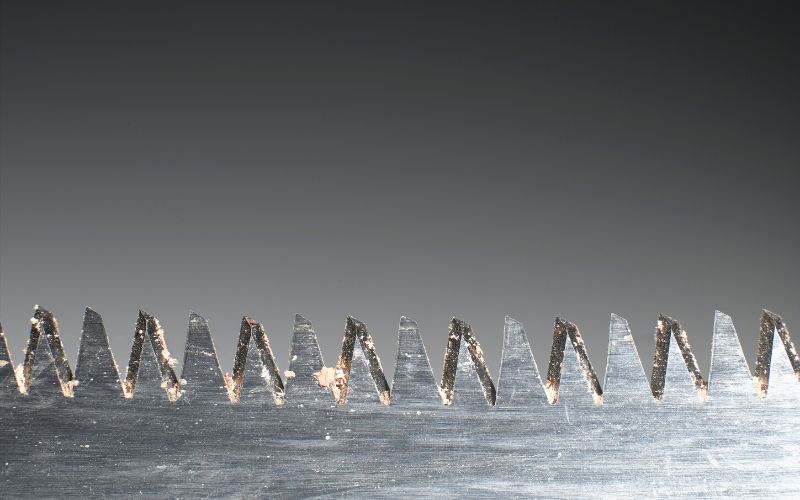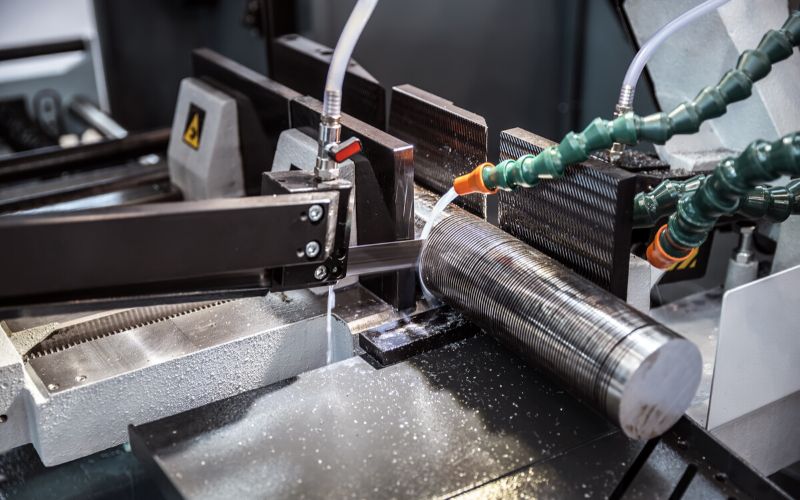One of the best ways of reducing the operational cost of your band saw is by choosing and equipping it with the right saw blades.
There are lots of options when it comes to choosing band saw blades, as they come in different sizes and properties that ally them with different materials.
In an ideal world, you’d change your band saw blade each time you’re cutting a different material with the saw, so as to match the blade with the material for maximum performance.
We all know however, that’s not practical in the real world and might not even be possible based on your working circumstances.
What’s most likely however, is choosing a single blade that works well for cutting different types of materials or the range of materials you work with.
As a metal fabricator or woodworker, choosing the right bandsaw blade is undoubtedly important to you. That’s why we’ve put together this guide to help you make the right choice that will not only help you reduce cutting cost, but also allow you to achieve the best finish in the cuts you make with it.
Table of Contents
Factors you must consider when choosing a band saw blade
If you want to choose the best or right band saw blade for use in your metal fabrication or woodworking shop, then it’s important you pay attention to the following factors when making your choice.
Geometry or shape of the blade – band saw blades terminology
One of the most important factors that will or should determine the band saw blade you use is the geometry or shape of the blade itself.
The shape of the blade affects how fast you can cut with the blade without stripping the teeth or damaging it and the type of materials you can cut with it.
Talking about the shape or geometry of band saw blades, we use certain terminologies to describe it. This band saw blades terminology describes the different parts of the blade and how it affects the use of that blade.
So, here are the blade terminologies and how they should affect your selection.
Related: 9 Bandsaw Resawing Tips That Will Turn You Into A Pro

Rake angle: the rake angle is the angle of the tooth face measured with respect to an imaginary perpendicular line to the cutting direction of the saw.
When selecting a band saw, you should choose one with a rake angle suitable for the type of material you’re planning to cut.
If you’re cutting thick solid metals and heavy-wall tubing, go for a blade with a positive rake angle. For structural steel and bundle cutting, a straight or less positive rake angle is ideal.
Tooth shape: when selecting a band saw blade, the shape of the tooth is very important, as it determines the type of material you can cut with it.
Regular: the regular tooth shape is like a standard or conventional shape with a straight or zero degree rake angle. It’s for general-purpose sawing.
Hook shape: This tooth shape is for cutting non-ferrous metals, non-metallic materials, plastic and wood. It has a 10-degree positive rake and it’s very good for fast cutting of these materials.
Skip: This is a tooth shape which also has a straight or zero rake angle but with a shallow gullets. Blades with this tooth shape are ideal for cutting large sections of wood, plastics and non-ferrous metals.
Width: the width or height of the blade is the distance from the tip of the tooth to the back of the blade band.
When it comes to blade width, you need to choose the widest blade your band saw can take especially when cutting straight lines.
Use ¾ inch or thinner width blades when you have to cut curves, shapes or contours.
Tooth pitch: this is the distance between the tip of one tooth to the tip of the next tooth, or it can also be defined as the number of teeth within a certain length of the blade say 1 inch.
If you’re cutting thin sections of a material, you need a blade with a fine pitch, that is more teeth per inch of the blade.
When cutting thicker sections however, you need one with fewer teeths per inch. For optimum cutting, make sure that between 6 to 12 teeth are in contact with the material you’re cutting at any given time, although you can go down to a minimum of 3.
Constant and variable pitch band saw blades: Constant pitch blades have teeth uniformly spaced throughout the length of the blade with. The teeth size, gullet depth and rake angle are uniform throughout the whole length.
You can choose these blades for general purpose cutting in your fabrication workshop.
Variable pitch blades on the other hand have varying tooth sizes and gullet depths throughout the length of the blade.
These blade are made to reduce noise and vibration and are ideal for cutting structural steel, tubing and solid materials. The reduced noise and vibration means you can make cuts quickly and smooth with these variable pitch blades.
Thickness: the thickness of the blade is the dimension of the blade from one side to the other side. The thicker the blade is, the better it is for making straight cuts because of the stiffness.
Thicker blades however have more tendency to break than thin blades. Thick blades are also less flexible, requiring larger band saw wheels to use them.
Back: the blade back is the body of the blade minus the tooth.
Tooth set: the set of a band saw blade is the tooth offset to the right and left of the thickness of the blade which provides enough clearance for the blade back to pass through the kerf.
The tooth set helps to clear materials or chips from the kerf, allowing the blade to move through the material without binding.
Tooth per inch: TPI or tooth per inch is the number of teeths per inch of the length of the band as measured from gullet to gullet.
Gullet: the gullet of the band saw blade is the curved area at the base of the tooth.
Gullet depth: it’s the distance between the bottom of the gullet to the tip of the blade tooth.
Tooth face: it’s the surface of the tooth starting from the tip that comes in contact with the material being cut, and on which chips from the material are formed.
Blade material and workpiece material

There are different types and shapes of materials used in the metal fabrication industry.
Depending on what you make use of in your shop, there are solid metal materials, thin-walled and heavy-walled metal pipes with different shapes, configuration and size, and there are special allow steel materials as well.
To cut these materials, you need special band saw blades that are hard enough to cut solid metals and heavy-walled tubes and can also withstand the impact delivered in shops that focus on cutting shapes and bundles.
Talking about blades like this, one option you can go for is a bimetal blade. Bimetal blades are blades produced from two types of metals, with the tip consisting of high-speed steel and the back made from high-strength steel.
This type of blade has unique properties that allow you to cut both solid metals, heavy pipe tubing, shapes and even allows with it.
Earlier bimetal blades are made using electron beam welding to join the high-speed steel tooth with the high-strength steel backer.
But today, many bimetal blades are made using diffusion bonding to join the two metals making the blade more resistant to stripping, which is a common issue faced when cutting with a band saw.
Apart from high-speed steel tooth bi-metal band saw blades, there are also carbide tipped or carbide-tooth bimetal blades which are ideal for cutting high allow steels such as nickel allow steel.
Cutting these type of alloys generate a great deal of heat and carbide can withstand considerably more heat than high-speed steel. The geometry of the carbide tooth also allows for high-speed operations ideal for large scale production shops.
When neither carbide-tipped blades nor standard bimetal blades will not be suitable for the material you want to cut, coated bimetal blades are another option you can go for.
Coated bimetal blades are coated with materials such titanium nitride to increase wear resistance, performance and tool life of the blade.
Bimetal blades are also modified with heat treatment to achieve the right balance of hardness and toughness.
Here’s a chart showing recommended number blade teeth for various materials and the thickness of the materials.
Symptoms of a dull band saw blade
One of the issues you’d have to deal with when using a band saw blade is dullness. No matter how sharp your band saw blade is, it will eventually get dull after several use.
You on your part however, can take some precautions to reduce the rate at which your blades get dull. First, you have to choose the right blade for the right material.
Your blade will get dull quickly if the metal or material you’re cutting with it is too hard for the blade pitch. This will cause the blade to wear and get dull at an abnormal rate.
Another reason of blade wear and dullness comes from feeding material heavily into a blade with a very fine pitch.
If you’re using a fine pitch blade, you can avoid excessive wear by slowly feeding the material into it, as the most obvious reason for getting a fine pitch blade is to get a good surface finish.
Just feed slowly and you’ll get the surface finish you desire while also preserving the sharpness of your blade.
Now, no matter how much care you take while using your blade, it will eventually get dull. When that happens, it’s important you know to avoid unnecessary strain on the machine, time wasting and even risk of the blade breaking.
Here are some symptoms that should tell you that your band saw blade is dull.
The most obvious symptom is that the blade will begin to cut slowly. If your blade is no longer cutting as fast as it used to, then there’s a chance that it might be dull.
It’s difficult to follow a line with a dull blade. Cutting curves or even straight lines with the band saw will be difficult because the blade will be forced from one side to the other going from side to side.
Apart from cast iron which always produces granular chips whether the blade is dull or not, dull bandsaw blades produce granular chips on all materials.
Carry out a finger test on the blade. If you’re experiencing the above symptoms, then carefully carry out a finger test on the blade when the machine is off/unplugged or when the blade is removed. Dull blades will obviously not feel sharp to your fingers.


I am looking for a 1/16 inch band saw blade for making sharp corners for tight design segmented woodturning projects. Where might I find some?